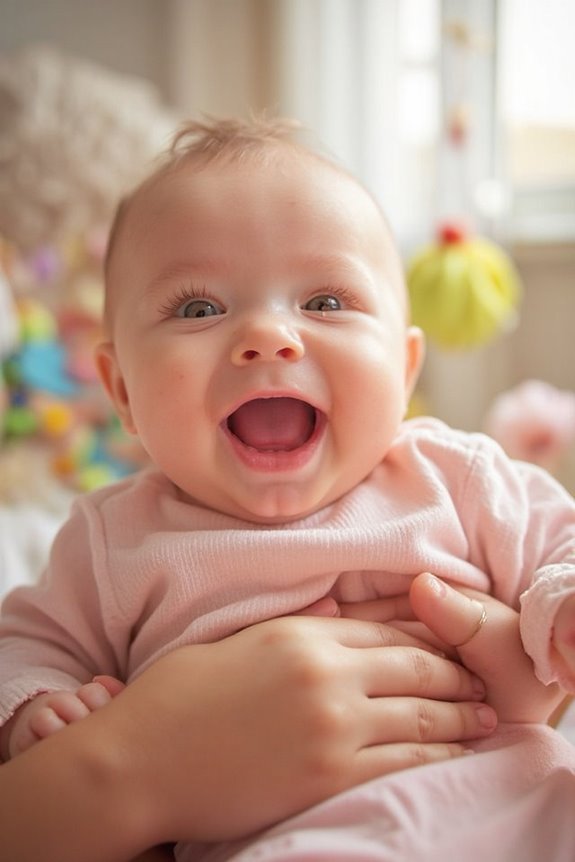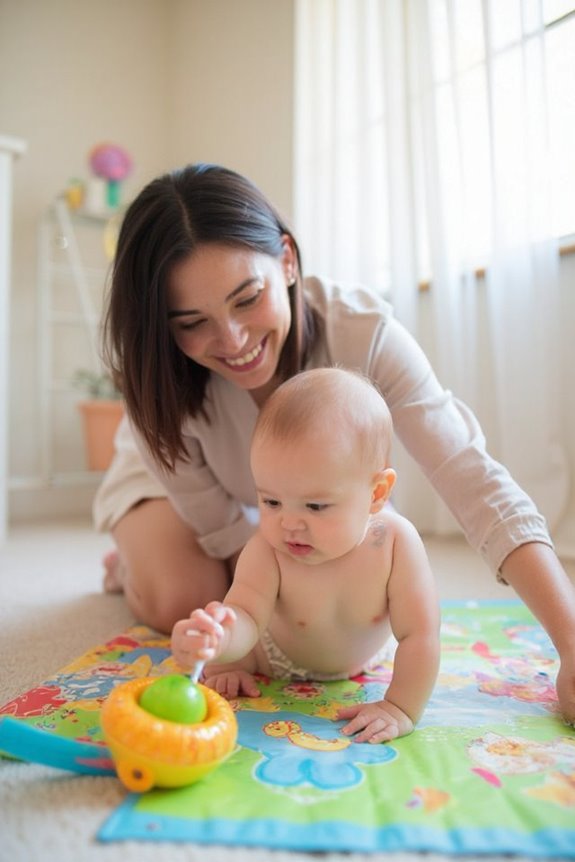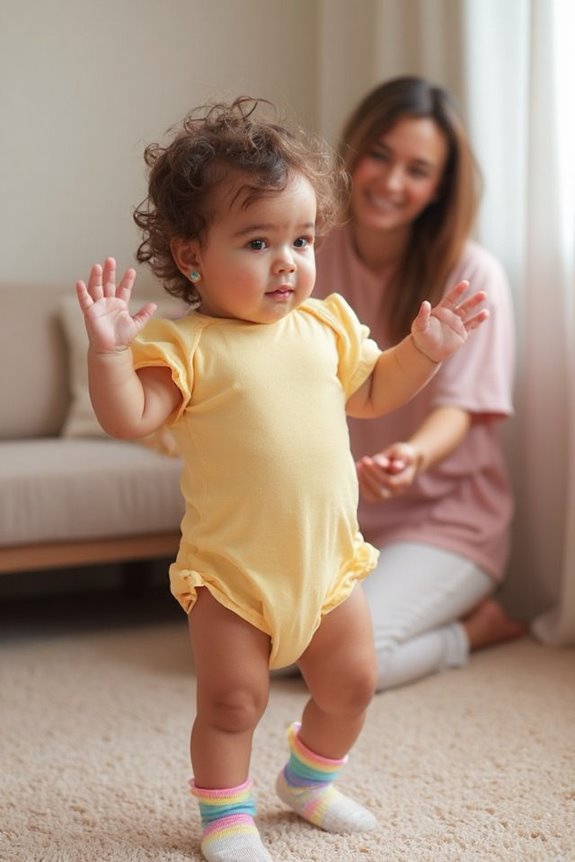Babies typically start laughing between 3 and 4 months of age, though some may begin as early as 11 weeks. These first chuckles usually evolve into full belly laughs by 5-6 months. Laughter emerges after earlier developmental milestones like smiling (6-8 weeks) and cooing. Common triggers include tickling, peek-a-boo, silly faces, and social interaction. If your baby hasn’t laughed by 7 months, consult your pediatrician. The sections below explore how this important milestone connects to your baby’s cognitive development.
Key Takeaways
- Most babies begin laughing between 3 and 4 months of age.
- Babies typically develop cooing and smiling before laughter emerges.
- Early laughter may be spontaneous, with full belly laughs developing by 5-6 months.
- Tickling, peek-a-boo, and silly faces are common triggers for baby laughter.
- Consult a pediatrician if your baby hasn’t laughed by 7 months.
The First Giggles: Typical Age Range for Baby Laughter
Those first baby laughs are magical moments that typically arrive between 3 and 4 months of age. As your baby develops, you’ll likely notice their initial chuckles emerge before full-blown laughter appears.
Giggle Milestones
- First chuckles: Around 4 months
- Full belly laughs: By 5-6 months
- Response to playful interactions: 4-6 months
Laughter variability is entirely normal among infants. While most babies begin laughing by 6 months, some may start as early as 11 weeks, while others take longer. This variation depends on both genetic and environmental factors.
If your baby hasn’t reached these giggle milestones by 7 months, consult your pediatrician for guidance, though remember that each child develops at their own pace.
Developmental Stages Leading to Laughter

Four key developmental milestones pave the way for your baby’s first laugh. The journey begins with early smiling milestones around 6-8 weeks of age, as your infant develops essential social reflexes.
Next comes the cooing progression, where your baby experiments with various sounds. This vocalization practice builds the muscle control needed for laughter.
By the third stage, your baby develops increased sensory awareness, becoming more responsive to:
- Funny faces
- Playful voices
- Environmental sounds
- Movement and motion
Finally, social interaction skills emerge as your baby learns to form emotional bonds through expressions. During this phase, your responses to their attempts at communication reinforce these behaviors.
These developmental stages build upon each other, creating the neurological and physical foundation necessary for your baby’s first giggles.
What Makes Babies Laugh? Common Triggers

While your baby’s first giggles mark an exciting milestone, understanding what triggers these delightful sounds can help you encourage more laughter. Babies respond predictably to several stimuli:
- Physical play: Gentle tickling and peek-a-boo games often produce the biggest laughs
- Facial expressions: Exaggerated smiles or silly faces mirroring your baby’s expressions
- Social interaction: Direct engagement strengthens bonds while encouraging giggles
- Sound and music: Unusual noises, singing, or rhythmic patterns capture attention
- Visual stimulation: Bright colors and moving objects can trigger happy responses
Babies also experience emotional contagion—laughing when they sense your joy. Surprise and novelty play important roles too, as unexpected events often result in delighted laughter. Interactive games that incorporate these elements will maximize your chances of hearing those precious chuckles.
From Smiles to Belly Laughs: The Evolution of Baby’s Humor

Your baby’s journey from first smiles to hearty laughter follows a fascinating developmental path that unfolds during their first six months. This smile evolution begins with reflexive grins that transform into social smiles around 6-8 weeks of age when they recognize your face or voice.
By 2-3 months, babies progress to cooing and gurgling sounds, experimenting with early communication. The first genuine giggles typically emerge between 3-4 months, though timing varies among infants.
Laughter triggers expand as your baby develops:
- Early stage: Faces and familiar voices
- Middle stage: Gentle physical play
- Later stage (5-6 months): Tickling, peekaboo, and surprise movements
Most babies develop full belly laughs by 6-7 months, marking an important social and emotional milestone.
Social and Cognitive Aspects of Baby Laughter

Beyond their adorable nature, baby laughs serve as essential indicators of social and cognitive development milestones. When your baby laughs, they’re engaging in a powerful form of social bonding that strengthens your connection and creates a secure environment.
Around 3-4 months, babies begin combining vocalizations with social smiles, developing their earliest expressions of humor. By 6 months, infants use social cues from caregivers to determine what’s funny, while at 12 months, they develop independent humor perception.
This progression reflects important developments:
- Brain development in the limbic system
- Emerging turn-taking skills in vocal exchanges
- Recognition of rhythmic patterns in interactions
- Understanding of unexpected situations
- Development of social referencing abilities
Laughter isn’t just delightful—it’s a window into your baby’s developing mind.
Cultural Differences in Baby Laughter Development
Just as babies reach developmental milestones at different rates, cultural factors play a crucial role in how and when infants develop laughter. Cultural values directly shape what parents consider appropriate laughter triggers and how they engage in play styles with their babies.
Research comparing American and Dutch babies reveals interesting differences:
- Dutch infants tend to be more easily soothed and affectionate
- American babies often display more active and vocal behaviors
Parental interaction varies greatly across cultures, influencing how babies learn to express emotions through laughter. These differences emerge through social learning, where infants observe and internalize cultural norms around emotional expression.
Despite these variations, laughter’s fundamental mechanism remains universal. Environmental influence on laughter patterns is evident in how different cultures emphasize physical play versus verbal stimulation, creating distinct developmental pathways.
Ways to Encourage Your Baby’s Laughter
Encouraging your baby’s laughter doesn’t require special training or expensive toys, though it does benefit from creativity and responsiveness to your infant’s unique personality. By incorporating playful interactions into your daily routines, you’ll create more opportunities for those precious giggles.
Try these approaches to stimulate laughter:
- Engage in peek-a-boo and other interactive games
- Use animated facial expressions and funny voices
- Introduce sensory surprises through different textures and sounds
- Incorporate gentle tickling (around 6 months)
- Create playful moments during bath time and feeding
- Use mirrors to show reflections
- Move to music with bouncing actions
Remember that babies develop at different rates, so be patient and attentive to what specifically triggers your baby’s unique laugh response.
Understanding Delayed Laughter Milestones
While most babies begin laughing between 3 and 4 months of age, it’s important to understand that developmental timelines vary greatly from child to child. Some infants may not laugh until 5, 6, or even 7 months old, which often falls within normal developmental ranges.
If you’re concerned about delayed milestones in your baby’s laughter development, I recommend monitoring other communication skills such as:
- Social smiling (typically appears at 6-8 weeks)
- Cooing and making vocal sounds
- Responding to your facial expressions
Environmental factors and social interactions greatly influence when babies develop laughter. Premature babies may also reach these milestones later than full-term infants.
When laughter concerns persist beyond 7 months, consulting with your pediatrician during regular developmental screenings can provide personalized guidance for your child’s unique situation.
The Science Behind Baby Laughter and Brain Development
Now that we’ve addressed delayed laughter milestones, let’s examine what’s actually happening in your baby’s brain when they laugh. When your infant giggles, their limbic system—the emotional center of the brain—is actively developing.
Laughter neuroscience reveals that these joyful sounds aren’t just cute; they’re critical developmental indicators:
- Your baby’s laughter strengthens neural pathways related to emotional processing
- Each laugh contributes to emotional bonding between you and your child
- The rhythmic patterns of shared laughter help establish early communication skills
Frequently Asked Questions
Can Babies Laugh in Their Sleep?
Did you know? 67% of infant behavior researchers note sleep laughter! I’ve observed baby giggles during sleep, but they’re likely reflexive responses rather than true laughter. Sleep movements can mimic waking behaviors without consciousness.
Do Premature Babies Follow the Same Laughter Development Timeline?
No, I adjust for premature milestones when tracking laughter cues. Preemies follow the same sequence but on a corrected timeline. I’ll calculate their adjusted age by subtracting weeks of prematurity from chronological age.
Can Excessive Laughing Indicate a Developmental Issue?
Precious patterns of play persist! I’ve found excessive laughter isn’t typically tied to developmental issues. While I monitor all developmental milestones, I don’t focus solely on laughter. If concerned, I’d consult my pediatrician for proper assessment.
Do Twins Develop Laughter at the Same Time?
I’ve observed that twin milestones often align, but laughter differences can occur. While twins typically develop laughter around the same time, individual personalities and environmental responses may create slight variations in their laughing patterns.
Can Babies Laugh Before They Can Smile?
95% of babies follow the same developmental sequence. I’ve studied early laughter in infants, and no, babies don’t laugh before smiling. Smiling is one of the first laughing milestones, typically preceding actual laughter by 1-2 months.
References
https://huckleberrycare.com/blog/when-do-babies-laugh-for-the-first-time
https://www.whattoexpect.com/first-year/first-laugh/
https://www.happiestbaby.com/blogs/baby/when-do-babies-laugh
https://www.pampers.com/en-us/baby/development/article/when-do-babies-start-laughing
https://www.parents.com/baby/development/laughing/babys-early-laughs/
https://www.healthline.com/health/when-do-babies-start-laughing
https://www.thebump.com/a/when-do-babies-laugh
https://www.healthline.com/health/baby/language-milestones-0-to-12-months
https://www.aexplorers.com/when-do-infants-start-to-laugh/
https://ideas.ted.com/meet-a-scientist-with-a-most-delightful-job-he-studies-baby-laughter/





